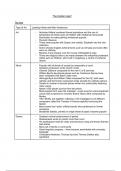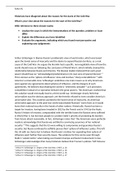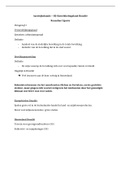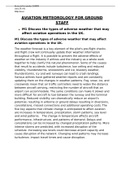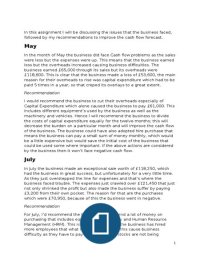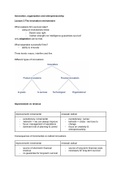The Golden Age?
The Arts
Type of Art Leading Artists and Main Audiences
Art - Nicholas Hilliard combined formal portraiture and the use of
perspective by those such as Holbein with mediaeval manuscript
illumination to make painting miniatures popular.
- Flemish influence
- These were popular with Queen and nobility. Elizabeth had her own
collection
- Some showed english achievements such as Armada and were often
worn on clothing
- Became more popular over the course of Elizabeth’s reign
- There are religious links to be made between the influential protestant
artists such as Holbein, who lived in Augsburg, a centre of Lutheran
reform.
Music - Popular with all levels of society but especially at court
- Greatest composers wrote church music
- Orlando Gibbons composed for the new C of E services
- William Byrd’s devotional pieces such as Cantiones Sacrae have
been compared with Bach’s later work
- Although Byrd and William Tallis composed for the CE, both were
catholic and the former composed works secretly for catholic patrons
- Growth in number of secular pieces written too, particularly featuring
male voices
- Nearly 1500 pieces survive from the period
- Most popular form were the madrigal - a part song for unaccompanied
voices with a pastoral or romantic theme. Many were composed by
Morley
- 1601 Morley put together collection of 25 madrigals by 23 different
composers called the Triumph of Oriana explicitly honouring the
Queen
- Many towns had ‘waits’ (official bands) who performed on formal
occasions
- Broadside ballads, printed on single sheet of paper, became popular
Drama - Greatest cultural achievement of period
- Shakespeare wrote for public more than court
- He emphasised need for order and structure using well known themes
and stories
- Many set in family or community
- Great linguistic progress →lines became assimilated with everyday
language
- Christopher Marlowe, Thomas Kyd and Thomas Dekker also
significant
, Literature - Literature was supported by court so depended on reading habits of
literate upper classes
- Foxe’s book of martyrs was most widely read prose
- Humanist, political and classical themes
- Classical translations were popular (Thomas North’s of Plutarch and
John Florio’s of Montaigne)
- Sir Philip Sidney was one of most prolific writers
- He wrote Arcadia which highlighted importance of monarch whose
power was limited by nobility
Architecture - Elizabeth did not build new palaces or patronise architecture due to
economic concerns
- However, her annual progresses encouraged leading courtiers to
entertain her through bigger and better houses
- They could afford to do so thanks to cheap monastic land previously
- Kenilworth Castle, Longleat House and Holdenby house are examples
Elizabethan architecture
- Robert Smythson was first named english architect would worked on
Longleat and Wollaton Hall
Shakespeare’s Elizabethan Plays
- 21 plays 1592-1602
- 7 in 1598 alone
- Included histories such as Richard III and Henry VI
Effect on Upper Class
- Popular society at this time had become associated with lower classes
- Printing press meant that more people had access to books and it became sign of class
to have lots
- Elitist culture focused on written not spoken word
- Old pageants and superstitions associated with catholicism
- Upper and middle classes saw their culture as superior and as a means of enforcing
social control over lower classes by removing elements of Catholic rite from their lives
Effect on Lower Classes
- Pastimes were an escape from poverty/inequality
- Shakespeare shows belief in dignity of the common man (grave digger in Hamlet)
The Arts
Type of Art Leading Artists and Main Audiences
Art - Nicholas Hilliard combined formal portraiture and the use of
perspective by those such as Holbein with mediaeval manuscript
illumination to make painting miniatures popular.
- Flemish influence
- These were popular with Queen and nobility. Elizabeth had her own
collection
- Some showed english achievements such as Armada and were often
worn on clothing
- Became more popular over the course of Elizabeth’s reign
- There are religious links to be made between the influential protestant
artists such as Holbein, who lived in Augsburg, a centre of Lutheran
reform.
Music - Popular with all levels of society but especially at court
- Greatest composers wrote church music
- Orlando Gibbons composed for the new C of E services
- William Byrd’s devotional pieces such as Cantiones Sacrae have
been compared with Bach’s later work
- Although Byrd and William Tallis composed for the CE, both were
catholic and the former composed works secretly for catholic patrons
- Growth in number of secular pieces written too, particularly featuring
male voices
- Nearly 1500 pieces survive from the period
- Most popular form were the madrigal - a part song for unaccompanied
voices with a pastoral or romantic theme. Many were composed by
Morley
- 1601 Morley put together collection of 25 madrigals by 23 different
composers called the Triumph of Oriana explicitly honouring the
Queen
- Many towns had ‘waits’ (official bands) who performed on formal
occasions
- Broadside ballads, printed on single sheet of paper, became popular
Drama - Greatest cultural achievement of period
- Shakespeare wrote for public more than court
- He emphasised need for order and structure using well known themes
and stories
- Many set in family or community
- Great linguistic progress →lines became assimilated with everyday
language
- Christopher Marlowe, Thomas Kyd and Thomas Dekker also
significant
, Literature - Literature was supported by court so depended on reading habits of
literate upper classes
- Foxe’s book of martyrs was most widely read prose
- Humanist, political and classical themes
- Classical translations were popular (Thomas North’s of Plutarch and
John Florio’s of Montaigne)
- Sir Philip Sidney was one of most prolific writers
- He wrote Arcadia which highlighted importance of monarch whose
power was limited by nobility
Architecture - Elizabeth did not build new palaces or patronise architecture due to
economic concerns
- However, her annual progresses encouraged leading courtiers to
entertain her through bigger and better houses
- They could afford to do so thanks to cheap monastic land previously
- Kenilworth Castle, Longleat House and Holdenby house are examples
Elizabethan architecture
- Robert Smythson was first named english architect would worked on
Longleat and Wollaton Hall
Shakespeare’s Elizabethan Plays
- 21 plays 1592-1602
- 7 in 1598 alone
- Included histories such as Richard III and Henry VI
Effect on Upper Class
- Popular society at this time had become associated with lower classes
- Printing press meant that more people had access to books and it became sign of class
to have lots
- Elitist culture focused on written not spoken word
- Old pageants and superstitions associated with catholicism
- Upper and middle classes saw their culture as superior and as a means of enforcing
social control over lower classes by removing elements of Catholic rite from their lives
Effect on Lower Classes
- Pastimes were an escape from poverty/inequality
- Shakespeare shows belief in dignity of the common man (grave digger in Hamlet)

